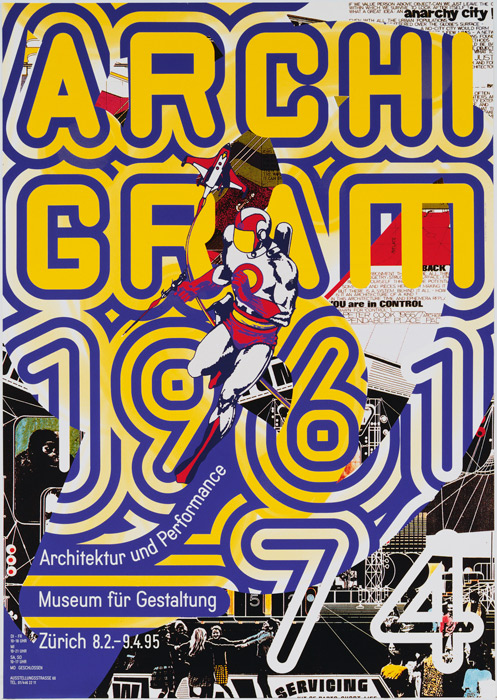
“Cut ‘n’ Paste: From Architectural Assemblage to Collage City” at Museum of Modern Art, New York
10 July-1 December 2013
Exhibition review by Claudia-Eve Beauchesne
For over a 100 years, Collage has been used in the creation of architectural renderings. “Cut ‘n’ Paste: From Architectural Assemblage to Collage City” illustrates the history of collage’s role in architectural representation. The exhibition draws from the MoMA’s Architecture and Design collection and features plans and proposals by Le Corbusier, Oscar Niemeyer, Archigram, and Rem Koolhaas, among others. Unfolding chronologically, the exhibition retraces the use of techniques such as photocollage, assemblage and digital techniques indebted to collage in architectural renderings up to the present day.
Some of the exhibition’s more striking pieces are Ludwig Mies Van Der Rohe’s little known photo-collages from the 1910s to the early 1960s. Mies Van Der Rohe pasted classical sculptures, natural textures (wood grain, water, etc.) and urban landscapes onto perspective line drawings to convey ideas for museums, monuments or convention halls. Influenced by the Berlin Dadaists’ photomontages, the pieces are so abstract that it is nearly impossible for viewers to project themselves into these imaginary spaces. Because their formal appeal supersedes the spatial concepts that they portend to describe, his photo-collages can now be appreciated as works of art independently of their original function as architectural renderings.
A section of “Cut ‘n’ Paste” illustrates a theory put forth by the architectural thinkers Colin Rowe and Fred Koetter in their 1978 treatise Collage City. Rowe and Koetter argued aesthetically successful cities are the result of the collision, superimposition and contamination of ideas imposed by successive generations of inhabitants. This section demonstrates Rowe and Koetter’s concept by breaking the exhibition’s chronological structure to feature a collage of works by mixed media artists, photographers, filmmakers and graphic designers who used techniques such as overlapping and juxtaposition to convey the fragmented nature and accelerated pace of urban life. Central to this part of the exhibition is Jacques de la Villeglé’s 1968 décollage, 122 rue du Temple, a physical manifestation of the layering of ideas and influences that make up the contemporary collage city.
By contrast, the successions of seamless computer-generated renderings included in the exhibition’s final section are much less visually appealing. Although conceptually pertinent, these trompe-l’oeil images lack the expressive and tactile qualities of older architectural proposals featuring hands-on collage techniques. Still, it is fascinating to look at various proposals for projects such as the renewal of Times Square, the Museum of Modern Art’s late 1990s expansion, and the World Trade Center Site memorial competition, and to imagine how New York City would look today if those concepts had been realized. A floor-to-ceiling digital rendering cut in wide strips doubles as the exhibition’s exit, suggesting that the idea of a flexible and ever-shifting collage city is still relevant today. Didactic but conceptually sophisticated, “Cut ‘n’ Paste” demonstrates how collage (considered both as a technique and as a theoretical concept) can bridge the gap between art, architecture and urbanism.
This review appeared in Issue 6 of Kolaj Magazine. To get your own copy or to subscribe, visit http://kolajmagazine.com/content/subscribe.
INFORMATION
Museum of Modern Art
11 West 53rd Street
New York, New York 10019 USA
(212) 708-9400
Hours:
Saturday-Thursday, 10:30AM-5:30PM
Friday, 10:30AM-8PM
Image:
Archigram 1961-74 (Museum für Gestaltung)
by Ralph Schraivogel
50 3/8”x35 5/8”
silkscreen
1995
Gift of the designer
Image courtesy of the Museum of Modern Art, New York
